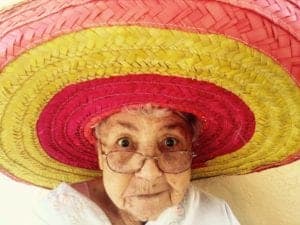The Problem of Ageism

There is a problem that gets laughed at too often. It is called Ageism. Aging isn’t the problem. How we disparage it is.
Most people I talk to about aging say they are not looking forward to it. Advanced aging, that is.
As long as we are able to keep up our activities, traveling, visiting, volunteering, or even working we are are pretty happy, but the prospect of losing strength, mobility, or hearing causes shudders and a change in the topic of conversation.
We may crack a joke about our sagging flesh or balding head to cover a much deeper fear of old age. Doing so is a hallmark of ageism.
Ageism as a Mindset
Ageism is a mindset, often disguised in humor, that indicates just how prevalent our concerns are. Focused most often on physical changes…sagging boobs, loss of teeth, and wrinkles to name a few, we paint our existence as one to be ridiculed and avoided.
Cosmetics industries take advantage of these fears and we end up with images of women with purple hair and old men with knock knees showing beneath their Bermuda shorts.
I don’t know about you, but I don’t find these all that funny.
If I promoted similar images of people of color I would be considered racist.
If I poked fun at someone in a wheelchair I would be guilty of ‘ableism’.
And yet these kinds of images and jokes abound in the realm of aging. Ageism seems to be much more acceptable than the other ‘isms.’
My confession
Why do we allow this? I admit I am an ageist! I can laugh pretty heartily at a well timed joke or funny image about growing old.
Is that because I haven’t yet reached a doddering stage of old age?
Am I allowing my anxiety about old age to control my thinking?
Why am I careful about my language to describe someone of a different faith or nationality or even political persuasion lest I offend, yet when it comes to aging I laugh with everyone else?
And why would I laugh at anyone in pain?
The Challenge of Ageism
Is it possible that our biggest challenge as we age has more to do with fear and denial than it does with reality?
Realistically arthritic fingers, fragile hips, fading vision, creeping incontinence and pending death are not laughing matters. But they are authentic concerns.
Concerns that no one wants to talk about. So we hear jokes and read cartoons. And laugh.
Is Ageism the best answer?
How do we find support and acceptance for changes that we may have always considered unacceptable? Is humor the only tool we have?
Education is slowly changing our understanding of racism and how to avoid it.
There are excellent support groups, summer camps, and laws for accessibility that are moving people with disabilities into the mainstream.
But what is there for those who are marginalized by ageism?
One answer is to develop similar frameworks and resources dedicated to the effects of ageism. These might include educational programs, encouraging intergenerational dialogues to bridge the gap between octogenarians and adolescents, and working to change policies that allow age-based descrimination.
Well, this must be my younger mind speaking.
If and when there are such initiatives I can certainly back them, but the activist in me has drawn the line at protests and late night council meetings.
I have already aged out of many bureaucratic solutions to ageism, so my question becomes, what can I do as an individual, within my limited circle of friends, family and community to impact a systemic scourge of ageism in our world.
Some Individual Steps to Stop Ageism
Here is a list of my initial, undeveloped thoughts about my responsibility as an older person when it comes to ageism. I can:
- Share personal stories of aging with joy.
- Share articles that shed light on the strengths of the elderly.
- Model postive aging – this is big! I commit to embracing my age and living my life to the fullest to demonstrate that aging is a continuation of a vibrant life, lived differently.
- Support age-inclusive businesses that treat people of all ages with respect and that offer products and services geared toward older adults.
- Engage in intergenerational activities that bring youth together with older generations to dispel myths about aging and build mutual respect and understanding.
- Advocate for inclusive policies. This can be be done without engaging in political movements by requesting age-inclusive policies at local businesses, community centers, and within organizations I’m a part of.
- Seek and offer mentorship. Engaging in mentorships with younger folks helps bridge the age gap and allows for the exchange of knowledge, skill, and life experioences.
- Practice self-compassion – I can be kind to myself and reject internalized negativity about aging. I can recognize my self-worth at every stage of life.
- Grow in awareness of positive statistics— for example: A study of 14,000 adults over age 50, found that the people who had the highest satisfaction with aging had a 43% lower risk of dying from any cause over a four-year period compared with those who were the least satisfied.
These are just my initial thoughts about confronting the issue of ageism.
It is time.
We are the generation who is disempowered by ageism.
We have to begin somewhere.
One more step to take…sign up for The Reflective Pen
and keep an active mind!

